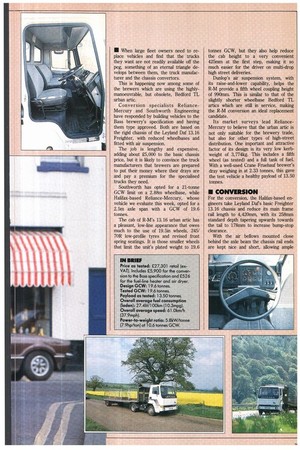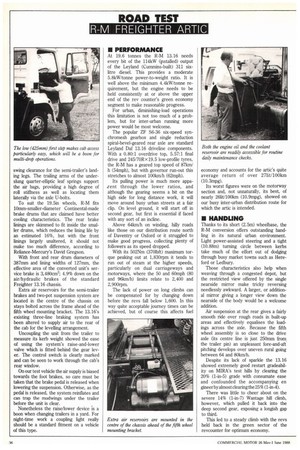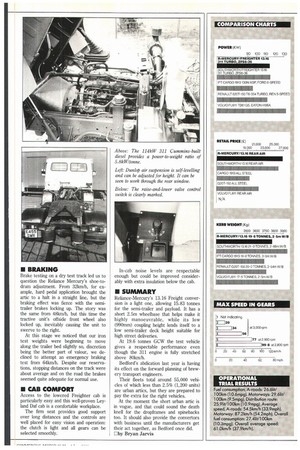• When large fleet owners need to replace vehicles and
Page 37

Page 38

Page 39

If you've noticed an error in this article please click here to report it so we can fix it.
find that the trucks they want are not readily available off the peg, something of an eternal triangle develops between them, the truck manufacturer and the chassis convertors.
This is happening now among some of the brewers which are using the highlymanoeuvrable, but obsolete, Bedford TL urban artic.
Conversion specialists RelianceMercury and Southworth Engineering have responded by building vehicles to the Bass brewery's specification and having them type approved. Both are based on the rigid chassis of the Leyland Daf 13.16 Freighter, with reduced wheelbases and fitted with air suspension.
The job is lengthy and expensive, adding about £5,000 to the basic chassis price, but it is likely to convince the truck manufacturers that brewers are prepared to put their money where their drays are and pay a premium for the specialised trucks they need.
Southworth has opted for a 21-tonne GCW limit on a 2.88m wheelbase, while Halifax-based Reliance-Mercury, whose vehicle we evaluate this week, opted for a 2.5m axle span with a GCW of 19.6 tonnes.
The cab of R-M's 13.16 urban artic has a pleasant, low-line appearance that owes much to the use of 19.5in wheels, 245/ 70R low-profile tyres and revised front spring seatings. It is those smaller wheels that limit the unit's plated weight to 19.6 tonnes GCW, but they also help reduce the cab height to a very convenient 425mm at the first step, making it so much easier for the driver on multi-drop high street deliveries.
Dunlop's air suspension system, with its raise-and-lower capability, helps the R-M provide a fifth wheel coupling height of 990mrn. This is similar to that of the slightly shorter wheelbase Bedford TL artics which are still in service, making the R-M conversion an ideal replacement candidate.
Its market surveys lead RelianceMercury to believe that the urban artic is not only suitable for the brewery trade, but also for other types of high-street distribution. One important and attractive factor of its design is its very low kerbweight of 3,774kg. This includes a fifth wheel (as tested) and a full tank of fuel. With a well-used Crane Fruehauf brewer's dray weighing in at 2.33 tonnes, this gave the test vehicle a healthy payload of 13.50 tonnes.
• CONVERSION
For the conversion, the Halifax-based engineers take Leyland Daf's basic Freighter 13.16 chassis and reduce its main frame rail length to 4,420mm, with its 258mm standard depth tapering upwards towards the tail to 178mm to increase bump-stop clearance.
With the air bellows mounted close behind the axle beam the chassis rail ends are kept nice and short, allowing ample swing clearance for the semi-trailer's landing legs. The trailing arms of the underslung quarter-elliptic leaf springs support the air bags, providing a high degree of roll stiffness as well as locating them laterally via the axle U-bolts.
To suit the 19.5in wheels, R-M fits 10mm-smaller-diameter Continental-made brake drums that are claimed have better cooling characteristics. The rear brake linings are skimmed to fit inside the smaller drums, which reduces the lining life by an estimated 16%, but with the front linings largely unaltered, it should not make too much difference, according to Reliance-Mercury's David Gregson.
With front and rear drum diameters of 387mm and lining widths of 127mm, the effective area of the converted unit's service brake is 3,480cm2; 4.9% down on the air/hydraulic brakes of the standard Freighter 13.16 chassis.
Extra air reservoirs for the semi-trailer brakes and two-pot suspension system are located in the centre of the chassis on stays bolted across the frame ahead of the fifth wheel mounting bracket. The 13.16's existing three-line braking system has been altered to supply air to the rear of the cab for the levelling arrangement.
Uncoupling the unit from the trailer to measure its kerb weight showed the ease of using the system's raise-and-lower valve which is fitted behind the gear lever. The control switch is clearly marked and can be seen to work through the cab's rear window.
On our test vehicle the air supply is biased towards the foot brakes, so care must be taken that the brake pedal is released when lowering the suspension. Otherwise, as the pedal is released, the system reinflates and can trap the mudwings under the trailer before the unit is clear.
Nonetheless the raise/lower device is a boon when changing trailers in a yard. For night-time work a coupling light really should be a standard fitment on a vehicle of this type.
• PERFORMANCE
At 19.6 tonnes the R-M 13.16 needs every bit of the 114kW (Ostalled) output of the Leyland (Cummins-built) 311 sixlitre diesel. This provides a moderate 5.8kW/tonne power-to-weight ratio. It is well above the minimum 4.4kW/tonne requirement, but the engine needs to be held consistently at or above the upper end of the rev counter's green economy segment to make reasonable progress.
For urban, diminishing-load operations this limitation is not too much of a problem, but for inter-urban running more power would be most welcome.
The popular ZF 56-36 six-speed synchromesh gearbox and single reduction spiral-bevel-geared rear axle are standard Leyland Daf 13.16 driveline components. With a 0.80:1 overdrive top, 5.57:1 final drive and 245/70R x19.5 low-profile tyres, the R-M has a geared top speed of 87km/ h (54mph), but with governor run-out this stretches to almost 100km/h (62mph).
Its pulling power is much more appasent through the lower ratios, and although the gearing seems a bit on the high side for long distance work, it will move around busy urban streets at a fair clip. On level ground, it will start off in second gear, but first is essential if faced with any sort of an incline.
Above 641cm/h on winding, hilly roads Like those on our distribution route north of Daventry or Oxford or it struggled to make good progress, collecting plenty of followers as its speed dropped.
With its 502Nm (370Ibft) maximum torque peaking out at 1,830rpm it tends to run out of steam at the higher speeds, particularly on dual carriageways and motorways, where the 50 and 60mph (80 and 961(m/h) limits relate to 2,400 and 2,90Orpm.
The lack of power on long climbs can be compensated for by changing down before the revs fall below 1,600. In this way quite acceptable journey times can be achieved, but of course this affects fuel economy and accounts for the artic's quite average return of over 271it/100km (10.3mpg).
Its worst figures were on the motorway section and, not unnaturally, its best, of nearly 261it/1001on (10.9mpg), showed on our busy inter-urban distribution route for which the artic is intended.
II HANDLING
Thanks to its short (2.5m) wheelbase, the R-M conversion offers outstanding handling in its natural urban environment. Light power-assisted steering and a tight (10.88m) turning circle between kerbs take much of the effort out of dodging through busy market towns such as Hereford or Ledbury.
Those characteristics also help when weaving through a congested depot, but the restricted view offered by the single nearside mirror make tricky reversing needlessly awkward. A larger, or additional mirror giving a longer view down the nearside of the body would be a welcome addition.
Air suspension at the rear gives a fairly smooth ride over rough roads in built-up areas and effectively equalises the loadings across the axle. Because the fifth wheel assembly is so close to the drive axle (its centre line is just 250mm from the trailer pin) an unpleasant fore-and-aft pitching develops over uneven rural going between 64 and 80Ion/h.
Despite its lack of sparkle the 13.16 showed extremely good restart gradeability on MIRA's test hills by clearing the 20% (1-in-5) grade with consumate ease and confounded the accompanying en gineer by almost clearing the 25% (1-in-4).
There was little to cheer about on the severe 14% (1-in-7) Wantage hill climb, however, which pulled it back into the deep second gear, exposing a longish gap to third.
This led to a steady climb with the revs held back in the green sector of the revcounter for optimum economy.
• BRAKING
Brake testing on a dry test track led us to question the Reliance Mercury's shoe-todrum adjustment From 321cm/h, for example, hard pedal application brought the artic to a halt in a straight line, but the braking effect was fierce with the semitrailer brakes locking up. The story was the same from 48km/h, but this time the tractive unit's offside front wheel also locked up, inevitably causing the unit to swerve to the right.
At this stage we noticed that our iron test weights were beginning to move along the trailer bed slightly so, discretion being the better part of valour, we declined to attempt an emergency braking test from 641cm/h. Despite our reservations, stopping distances on the track were about average and on the road the brakes seemed quite adequate for normal use.
• CAB COMFORT
Access to the lowered Freighter cab is particularly easy and this well-proven Leyland Daf cab is a comfortable workplace.
The firm seat provides good support over long distances and the controls are well placed for easy vision and operation: the clutch is light and all gears can be selected smoothly. In-cab noise levels are respectable enough but could be improved considerably with extra insulation below the cab.
• SUMMARY
Reliance-Mercury's 13.16 Freight conversion is a light one, allowing 15.83 tonnes for the semi-trailer and payload. It has a short 2.5m wheelbase that helps make it highly manoeuvrable, while its low (990mm) coupling height lends itself to a low semi-trailer deck height suitable for high street deliveries.
At 19.6 tonnes GCW the test vehicle gives a respectable performance even though the 311 engine is fully stretched above 80km/h.
Bedford's abdication last year is having its effect on the forward planning of brewery transport engineers.
Their fleets total around 55,000 vehicles of which less than 2.5% (1,200 units) are urban artics, but they are prepared to pay the extra for the right vehicles.
At the moment the short urban artic is in vogue, and that could sound the death knell for the dropframes and spinebacks too. It should also provide the convertors with business until the manufacturers get their act together, as Bedford once did. Oby Bryan Jarvis




































































































































